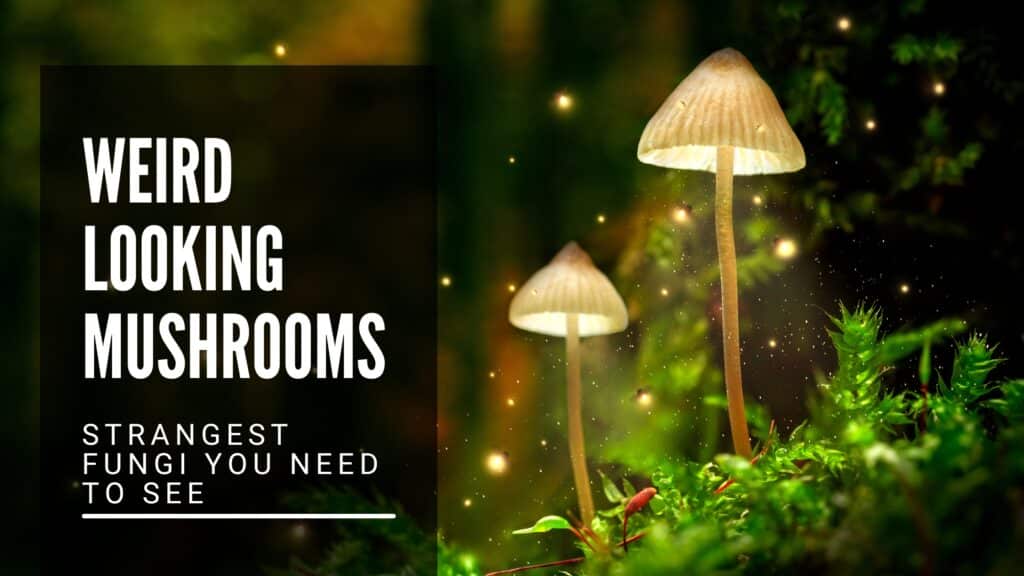Mushrooms are one of nature’s most diverse and intriguing organisms, coming in a stunning array of shapes, sizes, and colors. Among these, some stand out for their exceptionally bizarre and fascinating appearances. From mushrooms that look like they’re bleeding to those that glow eerily in the dark, the fungal kingdom never ceases to surprise and captivate. This article takes you on a journey through some of the world’s weirdest and most unusual mushrooms, each with its unique story and role in nature.
Quick Summary
- Lion’s Mane Mushroom: Resembles a lion’s mane, found in North America, Europe, and Asia, used medicinally.
- Turkey Tail: Colorful, fan-shaped, found on decaying hardwood worldwide, boosts immune system and gut health, contains PSK used in cancer therapy.
- Bleeding Tooth Fungus: Blood-like secretions, found in North America and Europe, intriguing properties.
- The Dead Man’s Fingers: Finger-like appearance, found on decaying wood, significant ecological role.
- The Bitter Oyster: Glows in the dark, found in North America, used in bioluminescence research.
- Octopus Stinkhorn: Octopus-like appearance, foul odor, found in Australia and Europe.
1. Lion’s Mane Mushroom (Hericium erinaceus)
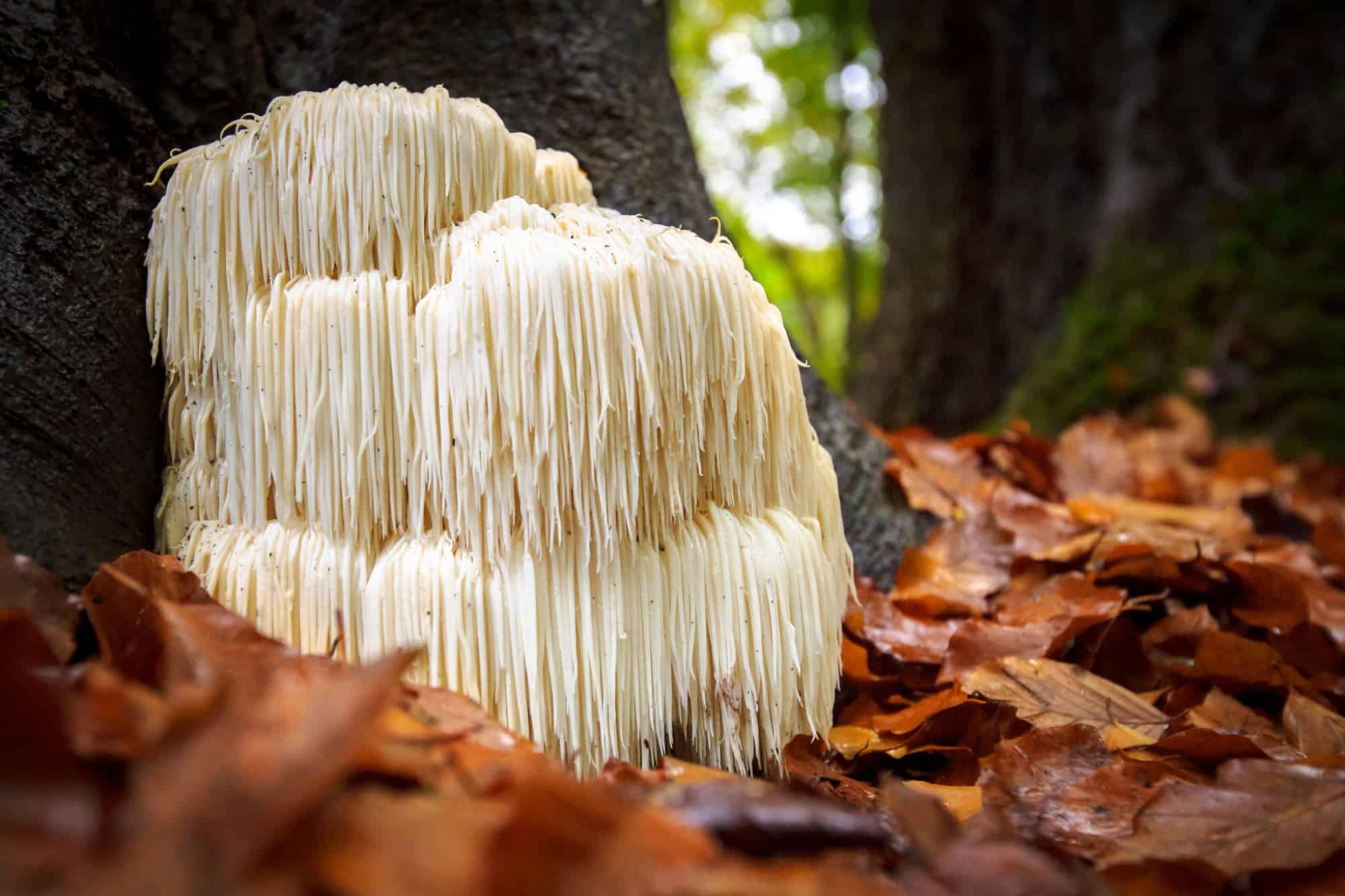
Description
The Lion’s Mane Mushroom, scientifically known as Hericium erinaceus, stands out due to its unique, shaggy appearance that closely resembles the mane of a lion. This fascinating fungus features cascading, icicle-like spines that start off a pristine white and gradually turn a yellowish-brown as they age. Its ethereal, almost otherworldly look has earned it various nicknames, including Bearded Tooth Mushroom, Hedgehog Mushroom, and Satyr’s Beard.
Habitat
Lion’s Mane mushrooms predominantly thrive in temperate forests, favoring dead or dying hardwood trees such as oak, beech, and maple. They are commonly found in North America, Europe, and Asia, particularly during the late summer to early autumn months. These mushrooms prefer shady, moist environments and can often be spotted on decaying trunks, branches, or stumps. Their affinity for hardwood makes them a vital component of the forest ecosystem, contributing to the decomposition process and nutrient cycling.
Uses
Lion’s Mane is celebrated for its impressive medicinal properties and diverse applications. Traditionally used in Chinese medicine, it has gained popularity in modern wellness for its potential cognitive and neurological benefits. Studies have shown that Lion’s Mane may stimulate the production of nerve growth factor (NGF), which is essential for the maintenance and regeneration of neurons. This makes it a promising natural remedy for neurodegenerative conditions like Alzheimer’s and Parkinson’s disease.
In the culinary world, Lion’s Mane is a gourmet delicacy, prized for its seafood-like flavor, often compared to crab or lobster. It’s commonly sautéed in butter or oil, enhancing its delicate taste and slightly chewy texture.
Beyond traditional and culinary uses, Lion’s Mane is widely available in various forms as a health supplement:
-
Mushroom Coffee: Combines the benefits of coffee with the cognitive-boosting properties of Lion’s Mane, providing a balanced and energizing start to the day.
-
Powders: Easily mixed into smoothies, soups, or other recipes, making it simple to incorporate the mushroom’s benefits into daily meals.
-
Capsules: Convenient and standardized doses of Lion’s Mane extract, making it easy to include in a daily supplement routine.
Whether used for its potential neuroprotective effects, as a gourmet ingredient, or in modern supplements, Lion’s Mane offers a range of benefits that make it a valuable addition to both the kitchen and the medicine cabinet.
Interesting Facts
-
Neuroprotective Effects: Research indicates that compounds in Lion’s Mane may enhance cognitive function, improve memory, and protect against age-related mental decline. Studies involving both animals and humans have shown promising results in brain health improvement.
-
Immune System Boost: Lion’s Mane contains polysaccharides, such as beta-glucans, which are known to boost the immune system. These compounds can stimulate the activity of the immune cells, helping the body to fend off infections and diseases.
-
Digestive Health: The mushroom’s anti-inflammatory properties may also benefit digestive health by protecting the stomach lining and reducing symptoms of gastritis and other gastrointestinal disorders.
-
Historical Usage: In addition to its medicinal and culinary uses, Lion’s Mane has been used in traditional Chinese medicine for centuries, often brewed into a tea or tincture for its health benefits.
Lion’s Mane’s captivating appearance and impressive health benefits make it a mushroom worth exploring, whether you’re a forager, a gourmet chef, or someone interested in natural remedies.
2. Turkey Tail (Trametes versicolor)
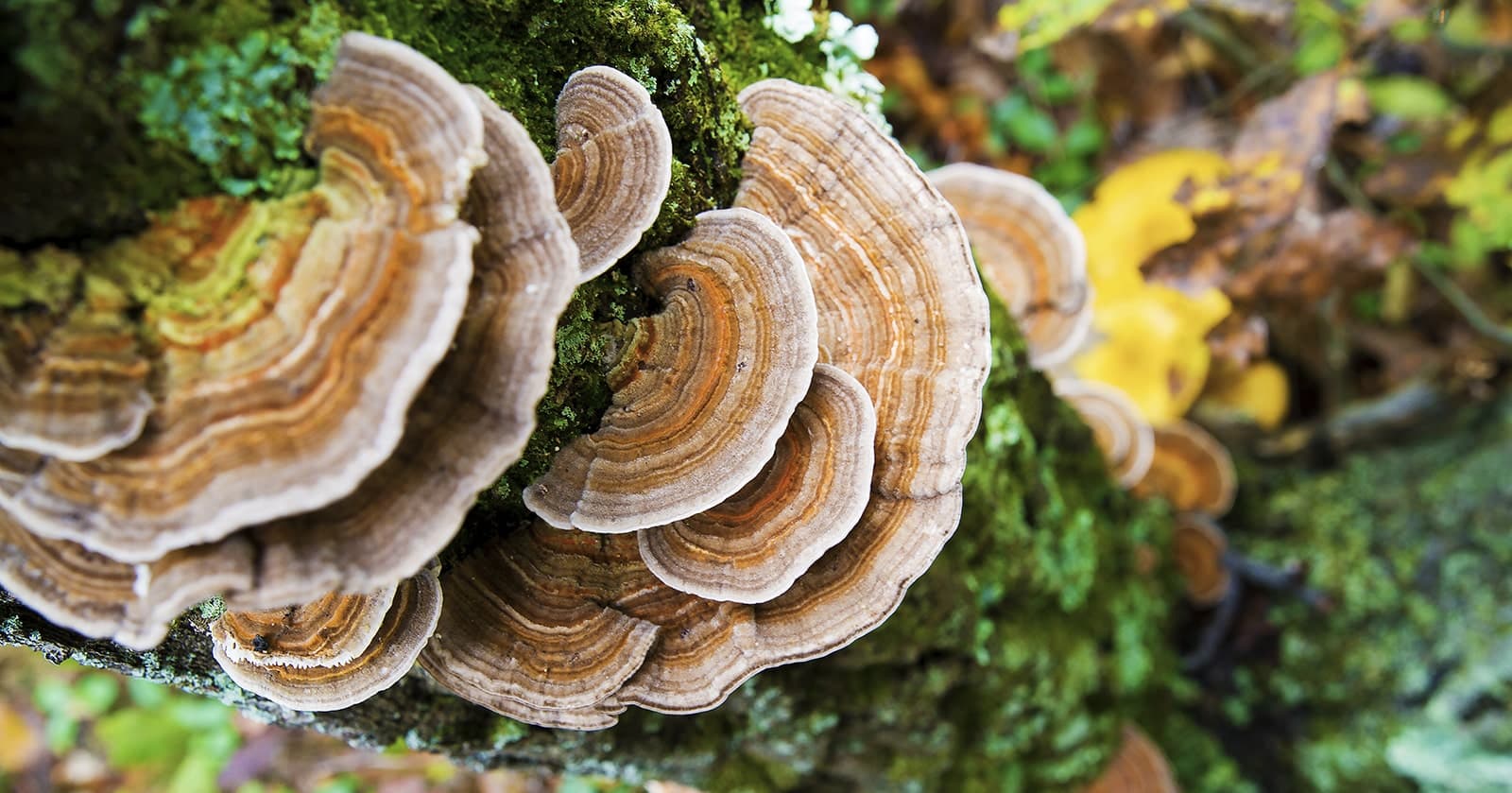
Description
Turkey Tail, scientifically known as Trametes versicolor, is a strikingly beautiful and colorful mushroom. Its common name derives from its appearance, which closely resembles the fanned tail of a wild turkey. The cap of the Turkey Tail mushroom displays concentric bands of varying colors, including shades of brown, tan, white, orange, and even blue or green, depending on the age and environmental conditions. These bands give the mushroom a velvety, textured look that makes it easy to identify. The underside of the cap is covered with tiny pores, rather than gills, which release spores for reproduction.
Habitat
Turkey Tail mushrooms are ubiquitous and can be found in forests around the world. They thrive on decaying hardwood trees and logs, playing a crucial role in breaking down dead wood and returning nutrients to the soil. They are particularly abundant in temperate forests in North America, Europe, and Asia. Turkey Tail mushrooms are perennial, meaning they can persist throughout the year, although they are most commonly spotted from late spring to early winter. They prefer moist, shaded environments and can often be found in large, overlapping clusters on fallen logs, tree stumps, and branches.
Uses
Turkey Tail mushrooms are renowned for their potent medicinal properties and versatile applications. They have been used for centuries in traditional Chinese medicine to support health and longevity. Modern science has validated many of these traditional uses, making Turkey Tail a popular choice in health supplements.
One of the most significant benefits of Turkey Tail is its ability to boost the immune system. It contains polysaccharide-K (PSK) and polysaccharopeptide (PSP), which are known to stimulate immune cell activity, enhancing the body’s ability to fight infections and diseases. PSK, in particular, is used as an adjunct therapy for cancer treatment in Japan.
Turkey Tail is also rich in prebiotics, which promote the growth of beneficial bacteria in the gut, improving digestion and overall gastrointestinal health. Additionally, its high antioxidant content helps protect cells from damage caused by free radicals, reducing inflammation and supporting overall well-being.
Turkey Tail is available in various convenient forms for everyday use:
-
Mushroom Coffee: Combines the immune-boosting properties of Turkey Tail with the energizing effects of coffee, making for a healthful and invigorating beverage.
-
Powders: Can be easily added to smoothies, soups, or other recipes, allowing for seamless integration of Turkey Tail’s benefits into daily meals.
-
Capsules: Provide a standardized dose of Turkey Tail extract, making it simple to incorporate this powerful mushroom into a daily supplement routine.
Whether used to enhance immune function, support gut health, or as part of a daily wellness regimen, Turkey Tail mushrooms offer a range of benefits that make them a valuable addition to both traditional and modern health practices.
Interesting Facts
-
Cancer Research: Turkey Tail’s immune-boosting properties have been extensively studied in the context of cancer treatment. PSK, derived from Turkey Tail, has shown promise in enhancing the efficacy of conventional cancer therapies and improving the survival rates of cancer patients.
-
Historical Use: In traditional Chinese medicine, Turkey Tail has been used for centuries to promote health and longevity. It is often brewed into a tea or taken as a powder or extract.
-
Environmental Benefits: Beyond its medicinal uses, Turkey Tail plays an essential ecological role. By decomposing dead wood, it helps maintain the health of forest ecosystems and promotes biodiversity.
Turkey Tail’s vibrant appearance and extensive health benefits make it a fascinating and valuable mushroom. Whether used in traditional remedies, modern supplements, or simply appreciated for its ecological importance, Turkey Tail is a mushroom that truly stands out.
3. Bleeding Tooth Fungus (Hydnellum peckii)
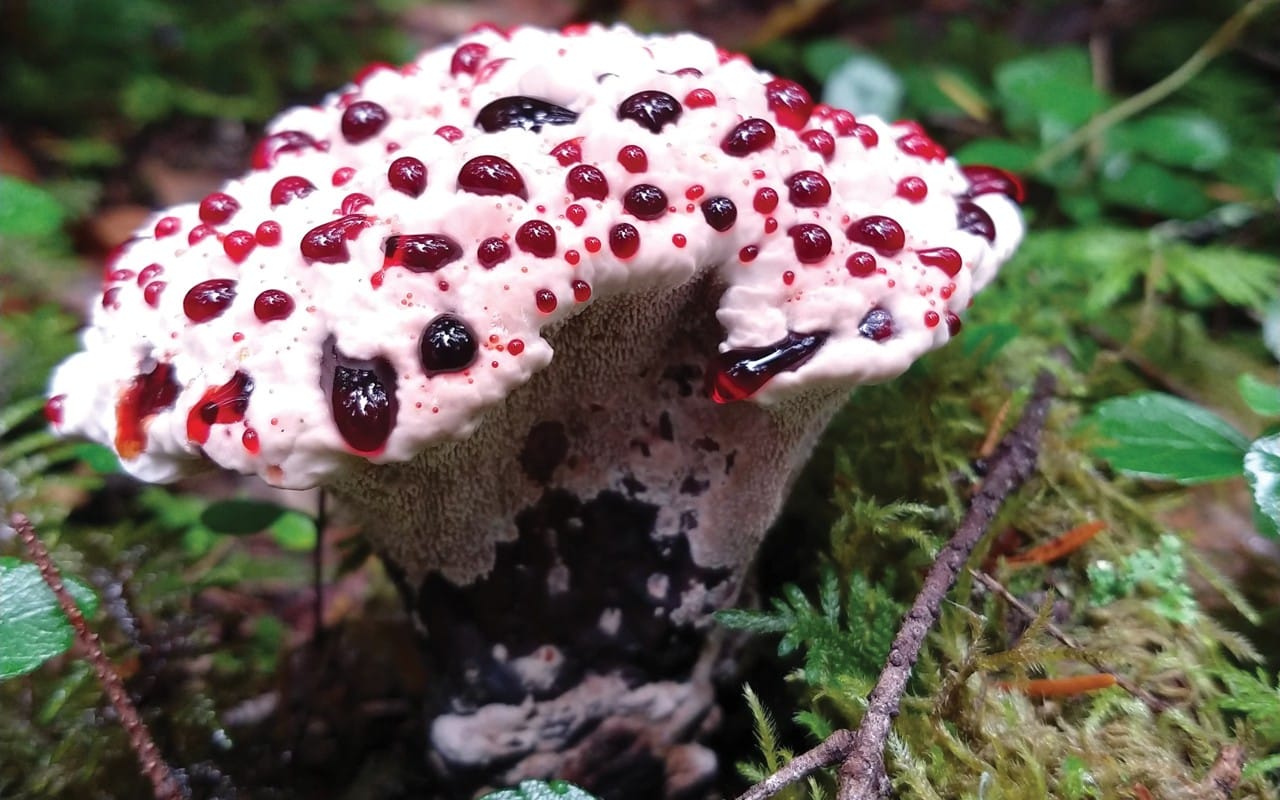
Description
The Bleeding Tooth Fungus, known scientifically as Hydnellum peckii, is striking for its unusual appearance. It features red, blood-like droplets on a creamy white to light pink cap, creating a dramatic and eerie look. These droplets are a type of sap exuded by the mushroom, rich in pigments that can stain the surrounding area. As the mushroom ages, the cap becomes more irregular and brownish.
Habitat
This unusual fungus thrives in coniferous forests, particularly in North America and Europe. It prefers moist, acidic soils and is often found growing among mosses and other fungi on the forest floor. Look for it in late summer to early autumn, usually under pine and spruce trees.
Uses
Although not edible due to its bitter taste, the Bleeding Tooth Fungus has interesting potential uses. Its pigments contain chemicals with anticoagulant properties, similar to heparin, which could be useful in developing medications for preventing blood clots. Some studies also suggest antibacterial properties.
Interesting Facts
-
Not Poisonous: Despite its alarming appearance, it is not poisonous, though its taste deters consumption.
-
Medicinal Potential: The red sap contains atromentin, a compound with anticoagulant and antibacterial properties.
-
Symbiotic Relationship: Forms a symbiotic relationship with trees, aiding nutrient absorption.
-
Aging Process: As it ages, the red droplets dry up and the cap turns brownish.
The Bleeding Tooth Fungus stands out for both its bizarre appearance and potential medicinal properties, showcasing the incredible diversity of fungi.
4. The Dead Man’s Fingers (Xylaria polymorpha)

Description
The Dead Man’s Fingers fungus, scientifically known as Xylaria polymorpha, has a creepy, finger-like appearance that looks eerily like decaying human fingers emerging from the ground or wood. Its black, club-shaped structures can make anyone do a double-take when spotted in the forest.
Habitat
This fungus is commonly found on decaying wood, especially on stumps and logs of hardwood trees like oak and beech. It thrives in temperate forests across Europe and North America, typically emerging in late spring and lasting through autumn.
Significance
Dead Man’s Fingers play a vital role in breaking down dead wood, helping to recycle nutrients back into the ecosystem. They are part of the natural process that maintains forest health and biodiversity.
Interesting Facts
-
Appearance: Often mistaken for actual dead plant material or even animal remains due to its eerie look.
-
Ecological Role: Essential decomposers, aiding in nutrient cycling within forest ecosystems.
-
Traditional Medicine: Sometimes used in traditional remedies for its potential antimicrobial properties.
Despite its unsettling appearance, the Dead Man’s Fingers fungus is an important part of the natural world, contributing to the health and sustainability of forest environments.
5. The Bitter Oyster (Panellus stipticus)
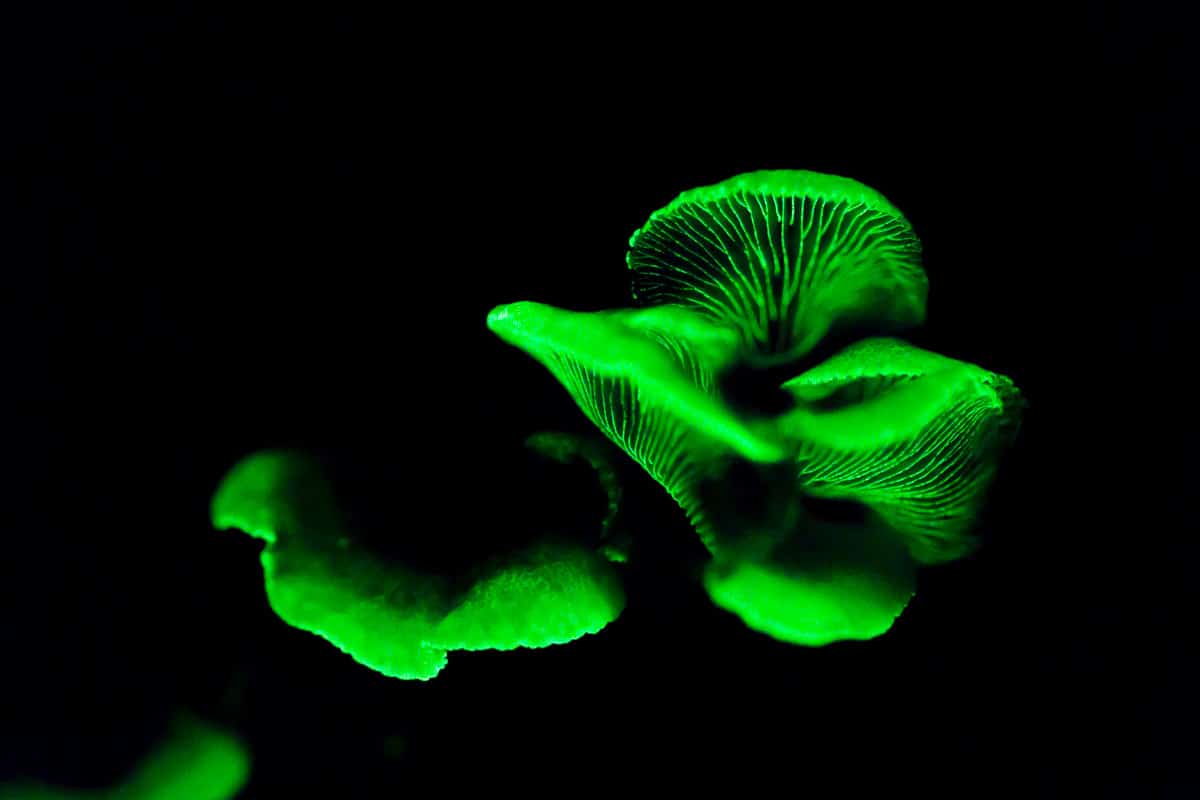
Description
The Bitter Oyster, known scientifically as Panellus stipticus, is a small, fan-shaped mushroom famous for its bioluminescence. Its caps are typically pale to yellow-brown and can glow with a greenish light in the dark, especially in humid conditions.
Habitat
This bioluminescent fungus grows on decaying wood, especially in moist, shaded areas of temperate forests in North America, Europe, and Asia. It’s often found on logs, stumps, and fallen branches.
Uses
While not edible due to its bitter taste, the Bitter Oyster is valuable in scientific research. Its glowing properties are studied for potential applications in bioluminescence research and bioengineering.
Interesting Facts
-
Bioluminescence: Emits a greenish glow in the dark, visible to the naked eye.
-
Chemical Reaction: The glow is due to a reaction involving luciferin, luciferase, and oxygen.
-
Research Interest: Studied for potential applications in scientific and medical fields.
The Bitter Oyster’s fascinating glow and scientific potential make it a remarkable example of the wonders found in the fungal kingdom.
6. Octopus Stinkhorn (Clathrus archeri)
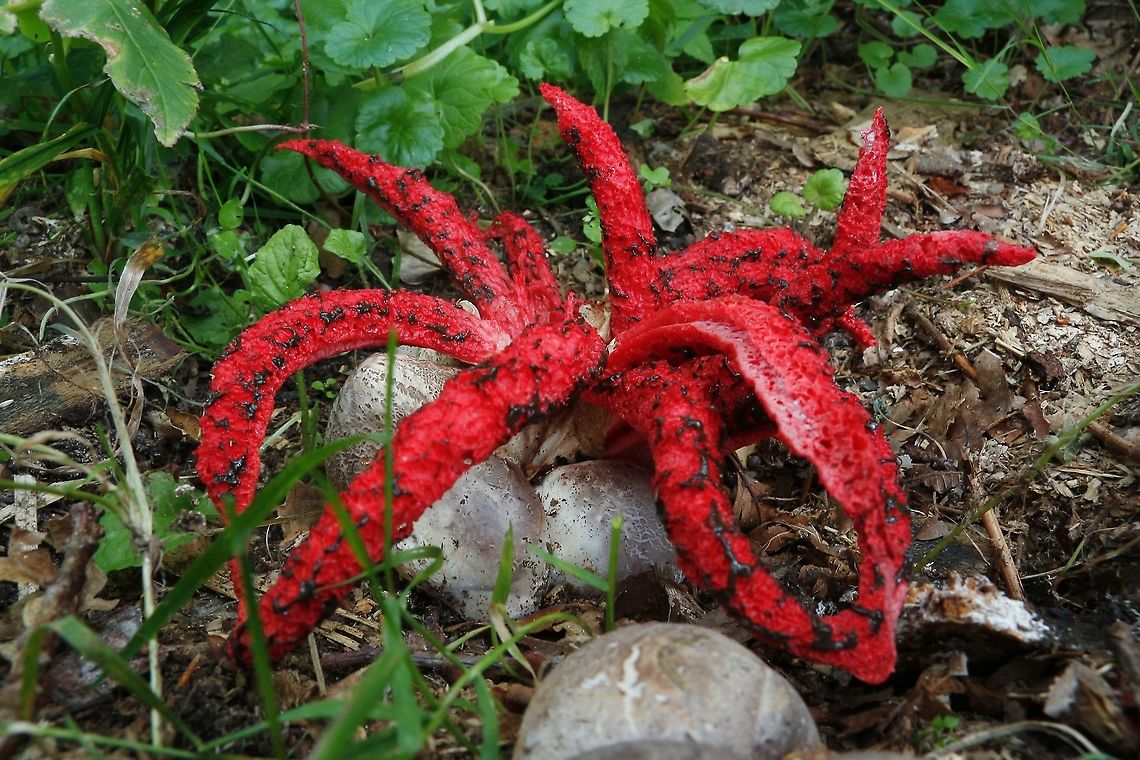
Description
The Octopus Stinkhorn, scientifically known as Clathrus archeri, looks like something out of a sci-fi movie. Its bright red, tentacle-like arms emerge from an egg-like base, spreading out in a star shape. Adding to its strangeness, it emits a foul odor reminiscent of rotting flesh.
Habitat
Originally native to Australia and Tasmania, the Octopus Stinkhorn has spread to parts of Europe and North America. It thrives in gardens, forests, and mulched areas, particularly during the warm, wet months of summer and autumn.
Significance
The Octopus Stinkhorn plays an essential ecological role by breaking down organic matter and recycling nutrients into the soil. Its strong odor attracts insects, which help disperse its spores.
Interesting Facts
-
Appearance: Its tentacle-like arms and bright red color make it easily recognizable.
-
Odor: The smell attracts flies, aiding in spore dispersal.
-
Invasiveness: Considered invasive in some regions outside its native habitat.
The Octopus Stinkhorn’s bizarre look and ecological role make it a captivating subject for both mycologists and nature enthusiasts.
Why Explore These Unique Fungi?
Studying and appreciating these unusual fungi is important for several reasons. Fungi play a crucial role in ecosystems as decomposers, breaking down organic matter and recycling nutrients. Some have significant medicinal properties, offering potential benefits for human health. Exploring the world of mushrooms can lead to new scientific discoveries and a greater appreciation for biodiversity.
By understanding these unique fungi, one can contribute to conservation efforts and promote sustainable practices. Additionally, the aesthetic and scientific value of these mushrooms makes them a fascinating subject for naturalists and researchers alike.
Conclusion
The world of mushrooms is filled with bizarre and fascinating specimens. From the brain-like Lion’s Mane to the eerie Dead Man’s Fingers, these fungi captivate our imagination and contribute to the diversity of life on Earth. Exploring these unique mushrooms can deepen our understanding of nature and inspire further curiosity and research.
References
Guggenheim, Alena G., et al. “Immune Modulation from Five Major Mushrooms: Application to Integrative Oncology.” Integrative Medicine: A Clinician’s Journal, vol. 13, no. 1, 1 Feb. 2014, pp. 32–44, www.ncbi.nlm.nih.gov/pmc/articles/PMC4684115/.
Jayachandran, Muthukumaran, et al. “A Critical Review on Health Promoting Benefits of Edible Mushrooms through Gut Microbiota.” International Journal of Molecular Sciences, vol. 18, no. 9, 8 Sept. 2017, p. 1934, www.ncbi.nlm.nih.gov/pmc/articles/PMC5618583/, https://doi.org/10.3390/ijms18091934.
Lai, Puei-Lene, et al. “Neurotrophic Properties of the Lion’s Mane Medicinal Mushroom, Hericium Erinaceus (Higher Basidiomycetes) from Malaysia.” International Journal of Medicinal Mushrooms, vol. 15, no. 6, 2013, pp. 539–554, https://doi.org/10.1615/intjmedmushr.v15.i6.30.

